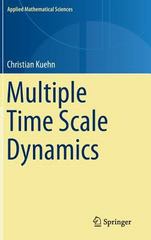Question
Please answer part e of this question. I have answered parts a-d as a reference. (15 points) The STATA data setFEV.dta consists of 12 observations
Please answer part e of this question. I have answered parts a-d as a reference.
- (15 points) The STATA data setFEV.dta consists of 12 observations on forced expiratory volume (FEV) in liters, and the height in cm of boys aged 10-14 years. The response variable isfev and the covariate isheight. Your goal is to use simple linear regression to understand the relationship between FEV and height.
a. Obtain and clearly state the estimate regression function. Plot the estimated regression function and the data. Does the linear regression function appear to give a good fit here? Discuss.
. regress fev height
Source | SS df MS Number of obs = 12
-------------+---------------------------------- F(1, 10) = 414.78
Model |6.02393375 1 6.02393375 Prob > F = 0.0000
Residual |.145233111 10 .014523311 R-squared = 0.9765
-------------+---------------------------------- Adj R-squared = 0.9741
Total |6.16916686 11 .560833351 Root MSE = .12051
------------------------------------------------------------------------------
fev | Coef. Std. Err. t P>|t| [95% Conf. Interval]
-------------+----------------------------------------------------------------
height | .0513112 .0025194 20.37 0.000 .0456975 .0569249
_cons |-5.312879 .39457 -13.46 0.000 -6.192036 -4.433722
The linear regression function appears to give a good fit here because the fitted regression line is close to all points.
b. Obtain point estimates of the following: (1) the difference in mean FEV for two boys aged 10-14 whose height differs by one cm, (2) the mean FEV for boys with height 161 cm, (3) ?6, and (4)?2.
- the difference in mean FEV for two boys aged 10-14 whose height differs by one cm 0.0513112
- ? = -5.312879 + 0.0513112x = -5.312879 + (0.0513112*161) = 2.9482242
- y - ?
y6 - ?6
y6 = 2.5
?6 = -5.312879 + (0.0513112*154) = 2.5890458
= 2.5 - 2.5890458
= - 0.0890458
- = 0.12051^2 = 0.0145
c. Test whether or not there is a linear association between FEV and height. State the alternatives, decision rule, and conclusion. What is the p-value of the test?
H0: There is no significant linear relationship between FEV and height (?=0).
Ha: There is a significant linear relationship between FEV and height (??0).
. correlate fev height
(obs=12)
| fev height
-------------+------------------
fev | 1.0000
height | 0.9882 1.0000
d. Estimate ? with a 99% confidence interval. Interpret your interval estimate. What does this result tell you about whether or not you would conclude there is a linear relationship between FEV and height at the 0.01 significance level?
Useful STATA:
lincom height, level(99)
. display invttail(10,0.005)
3.1692727
The 99% confidence interval
= ? 3.1692727(SE)
=0.0513112 3.1692727 (0.0025194)
=0.0433265, 0.05929586
The 99% CI is (0.0433265, 0.05929586).
At the 99% confidence level, the expected forced expiratory volume increases between 0.0433265 and 0.05929586 for each one unit increase in height.
The p-value is less than 0.01 hence we reject the null hypothesis and conclude that
there is a linear relationship between FEV and height.
. lincom height, level (99)
( 1)height = 0
------------------------------------------------------------------------------
fev | Coef. Std. Err. t P>|t| [99% Conf. Interval]
-------------+----------------------------------------------------------------
(1) | .0513112 .0025194 20.37 0.000 .0433264 .059296
------------------------------------------------------------------------------
e. Use this data to show that the following relationship is true:

Step by Step Solution
There are 3 Steps involved in it
Step: 1

Get Instant Access to Expert-Tailored Solutions
See step-by-step solutions with expert insights and AI powered tools for academic success
Step: 2

Step: 3

Ace Your Homework with AI
Get the answers you need in no time with our AI-driven, step-by-step assistance
Get Started


